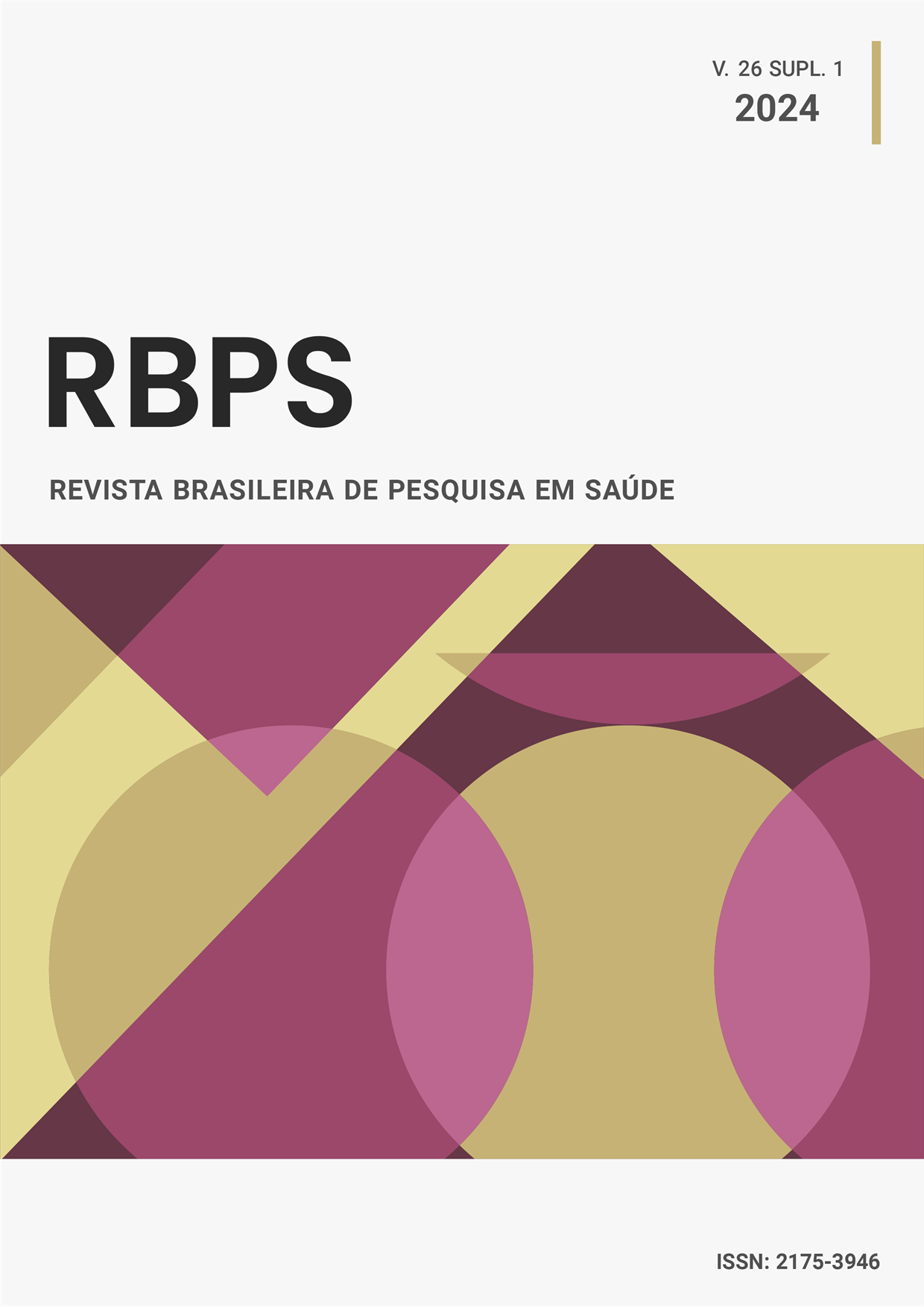Descriptive epidemiological study and impact on mental health and quality of life in patients with fibromyalgia at a Rheumatology Center
DOI:
https://doi.org/10.47456/rbps.v26isupl_1.44393Keywords:
Fibromyalgia, Epidemiology, Quality of life, DatabaseAbstract
Introduction: Fibromyalgia (FM) is a chronic syndrome associated with fatigue, sleep, mood and cognitive disorders and generalized musculoskeletal pain. Objectives: Evaluate the clinical profile of patients with FM, the most used treatments and the impact of this syndrome through specific scales. Methods: Descriptive study based on data from records from the Epifibro 2.0 Project of patients treated in an outpatient clinic of a Rheumatology Service, who met the American College of Rheumatology Diagnostic Criteria of 2010 for FM. Data collection was carried out through the application of questionnaires from the Epifibro 2.0 Project with epidemiological data and specific scores to evaluate the impact of FM on patients in the pain outpatient clinic of a Rheumatology service. The data were stored in an Excel spreadsheet and analyzed using the SPSS 20.0 program. Results: 69 patients were evaluated, with a mean age of 58.27 ±9.62 years and a predominance of females at 94,2%. It was observed that 59.4% of patients had been diagnosed for more than 10 years, 92.8% had completed high school and 86.7% had a family income greater than 3 minimum wages. The most prescribed medications were pregabalin and fluoxetine, whereas the most recommended non-pharmacological treatments were aerobic exercises. The means of the PDS, FIQR, GAD-7, PHQ-9 questionnaires were moderate to severe. Conclusion: The patients analyzed had long-lasting illness and the most prescribed treatment was pharmacological treatment associated with aerobic exercise. The questionnaires demonstrated a population with moderate to severe impact on mental health and quality of life.
Downloads
References
Paiva ES, Martinez JE, Heymann RE. Fibromialgia. In: Moreira C, Shinjo SK, editors. Livro da Sociedade Brasileira de Reumato¬logia. 3rd ed. São Paulo: Editora Manole; 2023. p. 272-77.
Clauw DJ. Fibromyalgia and related syndromes. In: Hochberg MC, Silman AJ, Smolen JS, Weinblatt ME, Weisman MH, edi¬tors. Rheumatology. 5th ed. Philadelphia: Mosby Elsevier; 2011. p. 769-82.
Smythe HA, Moldofsky H. Two contributions to understanding of the “fibrositis’’ syndrome. Bull Rheum Dis. 1977;28:928-31.
Heymann RE, Paiva ES, Martinez JE, Rezende MC, Provenza JR, et al. Nova Diretriz para diagnóstico de fibromialgia. Rev Bras Reumatol. 2017;57(S2):S467–S476.
Athayde IB, Marques ETF, Côrtes JPR. Uma abordagem geral da fibromialgia: revisão da literatura. REAMed. 2022;17:1-6.
Yunus M, Masi EM, Calabro JJ, Miller KA, Feigenbaum SL. Pri¬mary Fibromyalgia (Fibrositis) Clinical Study of 50 Patients with Matched Controls. Sem Arthr Rheum. 1981;11(1):151–71.
Provenza JR, Pollak DF, Martinez JE, Paiva ES, Helfenstein M, Heymann R, et al. Projeto Diretriz Fibromialgia. Sociedade Bra¬sileira de Reumatologia. 2004;1-13.
Wolfe F, Smythe HA, Yunus MB, Bennett RM, Bombardier C, Goldenberg DL, et al. The American College of Rheumatology 1990 Criteria for the Classification of Fibromyalgia. Report of the Multicenter Criteria Committee. Arthritis Rheum. 1990;33:160-72.
Wolfe F, Clauw DJ, Fitzcharles MA, Goldenberg DL, Katz RS, Mease P, et al. The American College of Rheumatology prelim¬inary diagnostic criteria for fibromyalgia and measurement of symptom severity. Arthritis Care Res (Hoboken). 2010;62:600-10.
Wolfe F, Clauw DJ, Fitzcharles MA, Goldenberg DL, Häuser W, Katz RS, et al. 2016 Revisions to the 2010/2011 fibromyalgia diagnostic criteria. Semin Arthritis Rheum. 2016;45(3):319-29.
Wolfe F, Ross K, Anderson J, Russell IJ, Hebert L. The prevalence and characteristics of fibromyalgia in the general population. Arthritis Rheum. 1995 Jan;38(1):19-28.
Senna ER, De Barros AL, Silva EO, Costa IF, Pereira LV, Ciconelli RM, et al. Prevalence of rheumatic diseases in Bra¬zil: a study using the COPCORD approach. J Rheumatol. 2004 Mar;31(3):594-7.
Martinez JE, Paiva ES, Rezende MC, Heymann RE, Junior MH, Ranzolin A, et al. EpiFibro (Registro Brasileiro de Fibromial¬gia): dados sobre a classificação do ACR e preenchimento dos critérios diagnósticos preliminares e avaliação de seguimento. Rev Bras Reumatol. 2017;57(2):129–33.
Heymann RE, Paiva ES, Junior MH, Pollak DF, Martinez JF, Provenza JR, et al. Consenso brasileiro de tratamento de fibro¬mialgia. Rev Bras Reumatol. 2010;50(1):56-66.
Wolfe F, Walitt B, Perrot S, Rasker JJ, Häuser W. Fibromyalgia diagnosis and biased assessment: Sex, prevalence and bias. PLoS One. 2018 Sep 13;13(9):e0203755.
Rezende MC, Paiva ES, Junior MH, Ranzolin A, Martinez JE, Provenza JP, et al. EpiFibro – um banco de dados nacional sobre a síndrome da fibromialgia – análise inicial de 500 mulheres. Rev Bras Reumatol. 2013 Oct;53(5):382–387.
Assis MR, Paiva ES, Junior MH, Heymann RE, Pollak DF, Provenza JR, et al. Dados de tratamento do Registro Brasileiro de Fibromialgia (EpiFibro). Advances in Rheumatology. 2020;60:1-5.
Cao QW, Peng BG, Wang L, Huang VQ, Jia DL, Jiang H, et al. Expert consensus on the diagnosis and treatment of myofascial pain syndrome. World J Clin Cases. 2021 Mar 26;9(9):2077-89.
Gequelim GC, Dranka D, Furlan JA, Mejia MM, Paiva ES. Estudo clínico-epidemiológico de fibromialgia em um hospital universi¬tário do Sul do Brasil. Rev Bras Clin Med São Paulo. 2013 Oct- Dec;11(4):344-9.
Júnior JO de O, Almeida MB. The current treatment of fibromy¬algia. Br J Pain. São Paulo. 2018 Jul-Sep;1(3):255-62.
Macfarlane GJ, Kronisch C, Dean LE, Atzeni F, Häuser W, Fluss E, et al. EULAR revised recommendations for the management of fibromyalgia. Ann Rheum Dis. 2017;76(2):318–28.
Atzeni F, Talotta R, Masala S, Giacomelli C, Conversano C, Nucera V, et al. Fibromyalgia: One Year Review 2019. Clin Exp Rheumatol. 2019 Jan-Feb;116(1):3-10.
Collado A, Rivera J, Alegre C, Casanueva B, et al. Fibromy¬algia: Old opinions versus new knowledge. Reumatol Clin. 2021;17(9):554-7.
Filho MAGO, Assis MR. Tratamento não farmacológico da fibromialgia. In: Braz AS, Ranzolin A, Heymann RE, editors. Dor Musculoesqueléticas Localizadas e Difusas. 3rd ed. Barueri [SP]: Editora Manole; 2022. p. 99-123.
Marques AP, Santos AMB, Assumpção A, Matsutani LA, Lage LV, Pereira CAB. Validation of the Brazilian Version of the Fibromyalgia Impact Questionnaire (FIQ). Rev Bras Reumatol. 2006;46(1):24-31.
Downloads
Published
Issue
Section
License
Copyright (c) 2024 Brazilian Journal of Health Research

This work is licensed under a Creative Commons Attribution-NonCommercial-NoDerivatives 4.0 International License.
Authors and reviewers must disclose any financial, professional, or personal conflicts of interest that could influence the results or interpretations of the work. This information will be treated confidentially and disclosed only as necessary to ensure transparency and impartiality in the publication process.
Copyright
RBPS adheres to the CC-BY-NC 4.0 license, meaning authors retain copyright of their work submitted to the journal.
- Originality Declaration: Authors must declare that their submission is original, has not been previously published, and is not under review elsewhere.
- Publication Rights: Upon submission, authors grant RBPS the exclusive right of first publication, subject to peer review.
- Additional Agreements: Authors may enter into non-exclusive agreements for the distribution of the RBPS-published version (e.g., in institutional repositories or as book chapters), provided the original authorship and publication by RBPS are acknowledged.
Authors are encouraged to share their work online (e.g., institutional repositories or personal websites) after initial publication in RBPS, with appropriate citation of authorship and original publication.
Under the CC-BY-NC 4.0 license, readers have the rights to:
- Share: Copy and redistribute the material in any medium or format.
- Adapt: Remix, transform, and build upon the material.
These rights cannot be revoked, provided the following terms are met:
- Attribution: Proper credit must be given, a link to the license provided, and any changes clearly indicated.
- Non-Commercial: The material cannot be used for commercial purposes.
- No Additional Restrictions: No legal or technological measures may be applied to restrict others from doing anything the license permits.






















